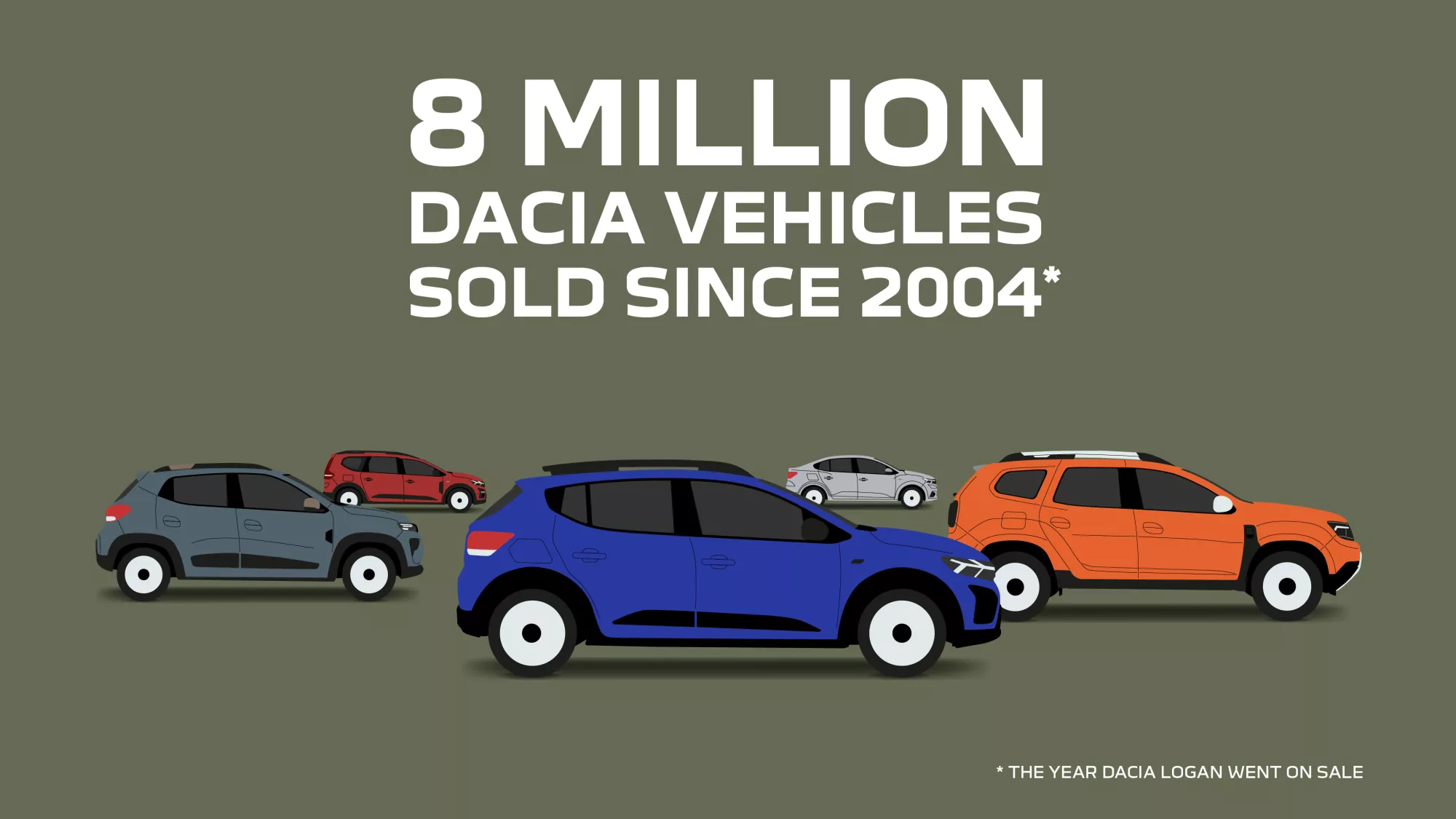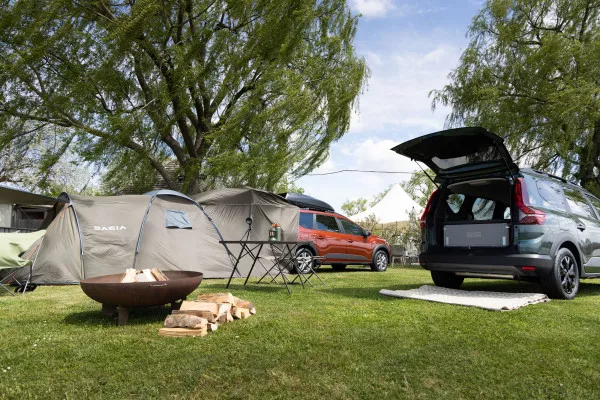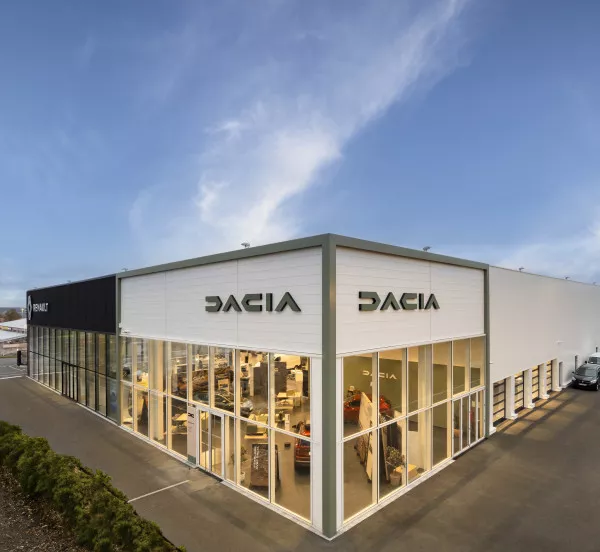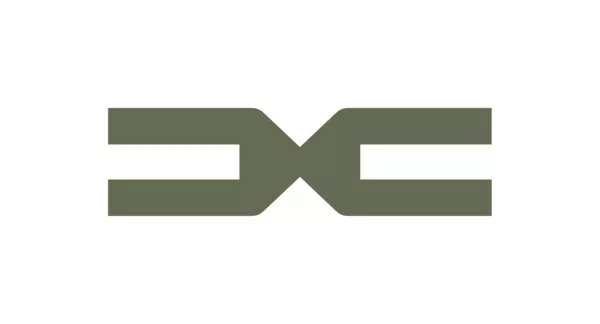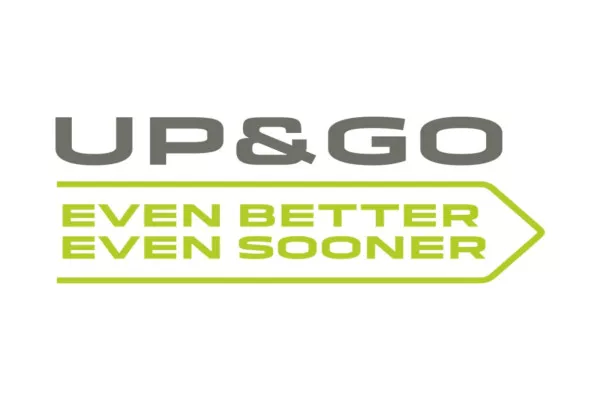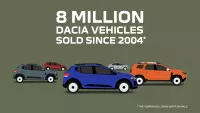8 million customers since 2004 – the Dacia success story continues
8 million. A symbolic milestone that reflects an incredible achievement and a source of immense pride. In 2023, Dacia sold its 8 millionth vehicle. Having gone from being the Romanian national manufacturer prior to 2004, to a major name renowned all throughout Europe, the brand has undergone a radical metamorphosis to become an unmitigated success story. But what are the assets, strengths and distinctiveness that characterise Dacia? Here are some visuals presenting key or surprising information about the Dacia journey over the past 19 years.
28 September 2023
A disruptive force in the automotive industry, Dacia is a brand unlike any other. Back in 2004, it introduced a new idea about consumption promoting a pragmatic vision for vehicles and constantly refocusing on what matters by offering the best value for money. And it works! Sales are constantly on the rise and the number of happy customers has now exceeded 8 million. So what makes Dacia different? Check out these images to find out.
Two lives, five logos
Did you know? Dacia hasn’t always been called Dacia.
The Romanian manufacturer that would go on to become Dacia was first established in 1968 and initially known as UAP, which stands for Uzina de Autoturisme Pitesti, or Pitesti car factory, in reference to the town on the river Arges in central Romania where the plant was based. The head office is still located there today.
The first Dacia logo is full of local and national references. The mountain in the background pays tribute to Romania and the Carpathian Mountains in particular. In the centre, the eagle comes from the coat of arms of the Arges County, in the region of Muntenia where the UAP head office is based.
The current name Dacia first appeared in 1980 on a black and white logo. It is directly inspired by “Dacii”, the Roman name for Romania.
The Renault Group acquired the Romanian manufacturer in 1999. In 2003, blue was added to the logo, which remained shaped like a shield. Featured on the front grille of the Dacia Logan, it was the brand’s first logo that became recognisable outside Romania and throughout Europe.
The brand inaugurated a new logo to mark the launch of the Sandero in 2008. The blue background made way for a light grey, while part of the shield shape was cut out in the middle.
In 2021, a new emblem called “Dacia Link” was developed to symbolise the trust between Dacia and its customers. It is made up of a D and C connected in the middle. The text logo comprises the five letters of the brand name presented in a minimalist font to reflect the brand personality – robust and elemental.
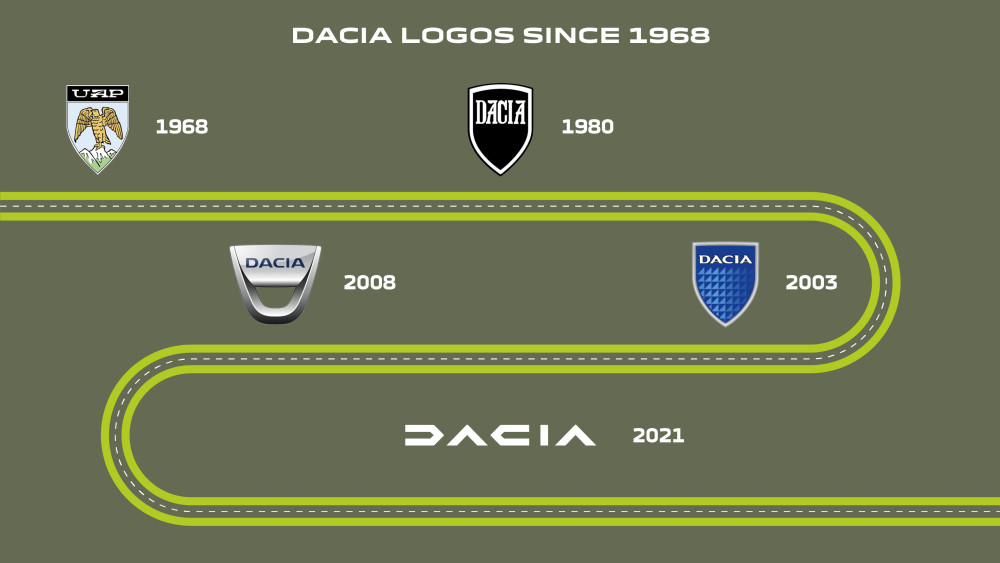
Vehicles sold across 44 countries
The first Dacia Logan launched in 2004 was initially supposed to be reserved for the Romanian market and then extended to Eastern European markets. However, given the strong sales, the model was made available in many countries across the continent. This was the first stone in the brand’s road to success.
Since then, Dacia models have been marketed in 44 countries around the Mediterranean.
Although its birthplace, Romania, figures in the brand’s top 5 countries, France represents its leading market in terms of sales, followed by Italy.
The brand is going from strength to strength. For the second consecutive year, Dacia is the leading retail brand in Europe. It is also heading the market in Portugal and Belgium, and third in France. This performance adds weight behind the brand’s positioning and the reflects quality of its vehicles.
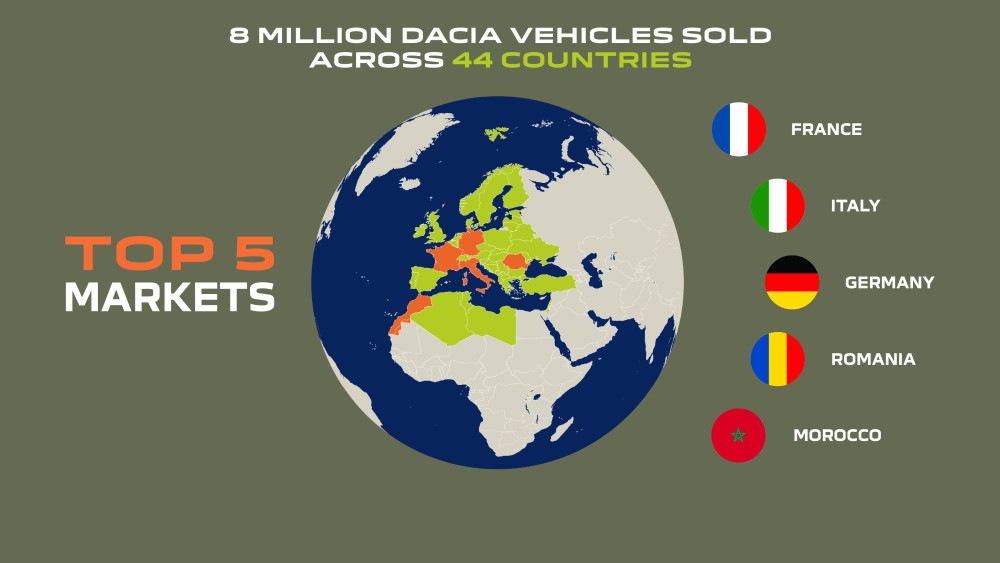
A brand in demand from retail customers
Nowadays, the Dacia range is structured around four pillars, each clearly defined and boasting attractive design. At unbeatable value for money, the range has won over many. Brand awareness is growing; everyone is Europe has now heard of Dacia.
Sales are constantly increasing. In 2022, Dacia reached record market share of 7.6% in the European retail market (compared with 6.2% in 2021). The brand now enjoys one of the highest conversion and loyalty rates in the market.
For the sixth consecutive year (since 2017), the Dacia Sandero was the most sold car in the European retail market. The Duster ranked second in 2022, and has also been the best-selling SUV to retail customers since 2018.

An attractive range full of iconic best-sellers
The core Dacia range comprises an electric city car, the all-electric Dacia Spring (since 2020), a compact hatchback, the Dacia Sandero, and its more adventurous version, the Sandero Stepway (since 2008), the Dacia Duster SUV (since 2010), and a seven-seater family car, the Dacia Jogger (since late 2021).
The saloon hatchback Logan continues to be sold in Eastern Europe.
This range of best-selling models enabled Dacia to reach the symbolic milestone of 8 million vehicles sold in 2023.
These figures prove that our customers have bought into the brand philosophy, which has never deviated from trailblazing, creativity and unbeatable value for money.
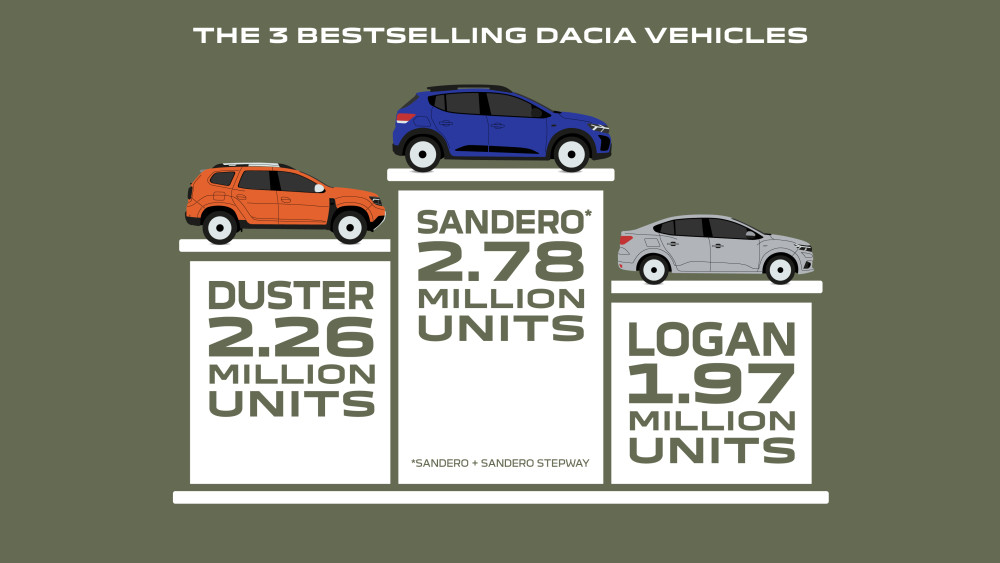
Three manufacturing plants
From a single factory in Romania before 2012, Dacia now operates three factories.
The brand’s first factory was based in Mioveni, Romania, which opened in 1968. It comprises a bodywork/assembly and understructure unit, a mechanicals unit as well as a foundry and a logistics platform. It produces a number of models, including the Logan, Sandero, Sandero Stepway, Duster and Jogger.
The factory in Casablanca, Morocco has been fully owned by the Renault Group since March 2019. Set up in 1959, it operates a bodywork/assembly unit and produces the Logan, Sandero and Sandero Stepway.
The Dacia factory in Tangiers, Morocco, came online in 2012. It operates a bodywork/assembly unit, a logistics platform, as well as an understructure and sub-assembly unit. This cutting-edge facility is both carbon neutral and has implemented zero liquid discharge. It produces the Logan, Sandero, Sandero Stepway and Lodgy.
Multi-rewarded models
While it was the Logan that made Dacia a household name in Europe, one of the brand’s all-time best-selling models is the SUV Duster. Marketed at the same price as a city car, the Duster, the 4x4 version of which boasts market leading off-road ability, is a mainstay in the Dacia range. This iconic model has won over 40 awards, including Car of the Year in Romania, Best SUV in the UK, Best Family Car in Germany and Belgium and much, much more.
The Jogger, a seven-seater family car, is unlike any other on the market. It has already been recognised with 13 awards, including Car of the Year in France, awarded by Argus.
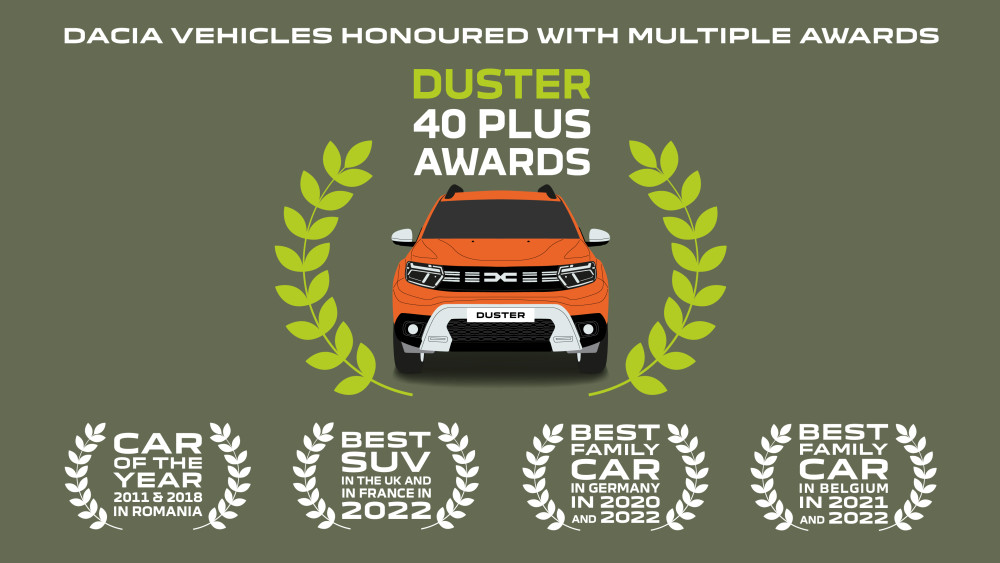
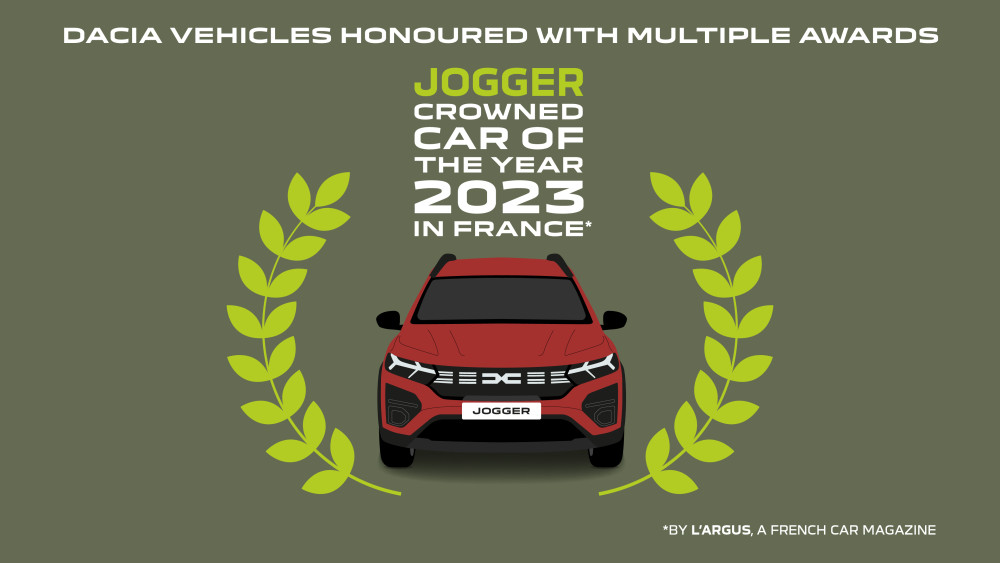
Memorable advertising slogans
Not only has Dacia disrupted the automotive market with its pared back models sold at affordable prices, it has also turned vehicle advertising on its head, coming up with quirky and amusing slogans. Certain taglines really caught the public’s imagination, in particular:
- The Dacia slogan: “Dacia, scandalously affordable”
- The Duster 1 ad in France “On va quand même pas dépenser si peu…” (we’re couldn’t possibly spend so little...)
- The Duster ad “Don’t worry, be Duster”, and “Si vous voulez un 4x4 juste pour grimper dans l’échelle sociale, vous pouvez juste aller voir ailleurs” (if you’re looking for a 4x4 to boost your social status, you should look elsewhere)
- The Dacia Sandero ad “A lawn mower option could be a good idea, could be. But in the new Dacia Sandero, we’ve decided to include a rear view camera. Because, it’s actually useful.”
- The Dacia Lodgy ad: “Some people would pay anything for a seat. Not you.”
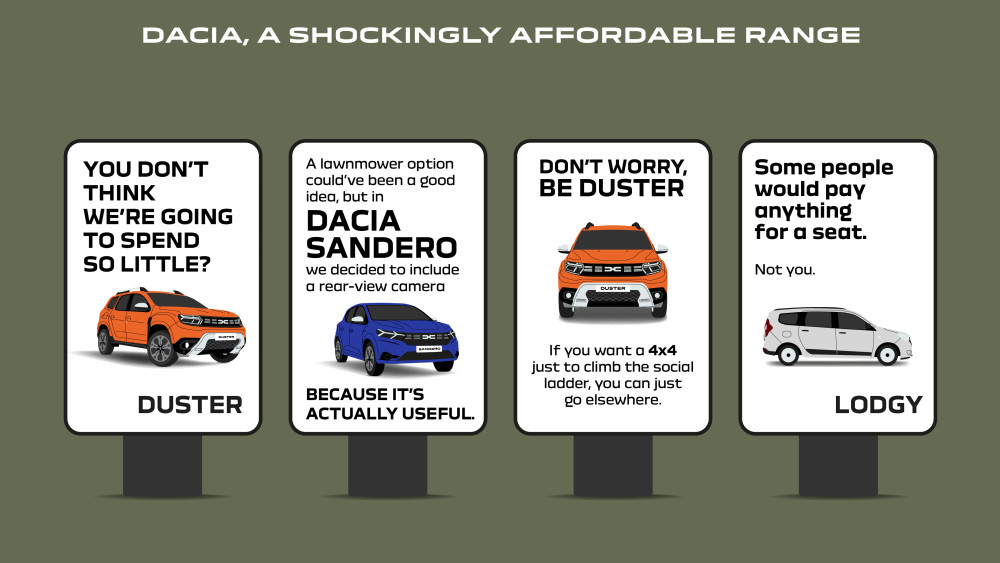
Above all, be clever
Dacia probably would not have been so successful, had it not been for its ingenuity. The brand has always known how to marry simplicity with innovation. Dacia vehicles gracefully sidestep unnecessary frills and gadgets. The brand is smart, and so are its customers!
One of the best examples of this are the Sandero’s mass-coloured front and rear skid plates. These components were the fruit of an intricate design process. It was important there were no irregularities or defects in the colour, which is why the material used to make the part is already coloured before it is injected into the mould. This makes the skid plates more durable and means any inevitable bumps and scratches are virtually invisible.
Fitted on the Jogger and the Duster, the modular roof bars can be transformed with just a few twists of a key. To help drivers transport any load, even the most unforeseen cargo, the roof bars can turn into a roof rack able to withstand up to 80 kg (bikes, skis, roof box etc.).
The fixed smartphone holder on the dashboard operated through Media Control and the removable phone holder next to the multimedia screen using Media Display/Media NAV make everyday connectivity concerns a thing of the past.
These innovative patented designs epitomise the Dacia spirit – smart, practical, simple and economical.
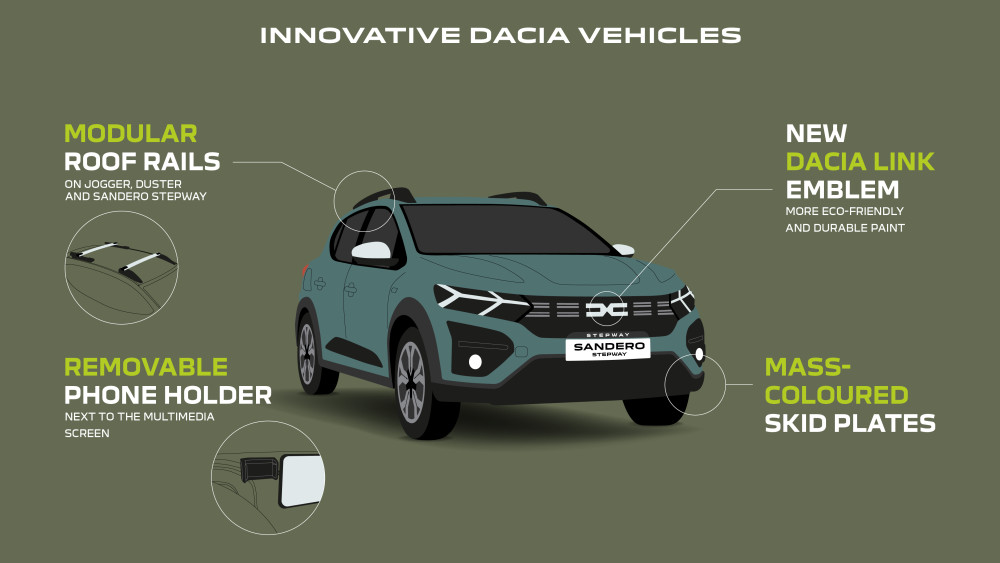
Profile of Dacia customers
Dacia is keen to satisfy the basic needs of its customers. To do this, it needs to understand who they are. Here are some details regarding the brand’s clientele:
- 66% are men
- 50% are aged between 55 and 74. The Jogger attracts the youngest customer base, with 55% of buyers aged 54 or under
- Over 50% no longer have children living at home. The Jogger stands out from the rest of the range, with 47% of customers with at least one child
- 40% of customers live in the countryside. People who purchase the Dacia Spring are the most rural (50%)
- They drive around 12,000 km on average each year, both in urban and rural settings
In the automotive market, customer expectations and habits are changing. Dacia is a modern brand that listens to its customers and addresses the concerns relating to the future of mobility.
Despite the environmental challenges facing society today, Dacia is the only manufacturer to equip every vehicle in its retail range with flex-fuel engines, and market an affordable electric vehicle, the Dacia Spring. Having been disrupting the automotive industry for the past 19 years, the brand is always looking to bring about the next revolution.

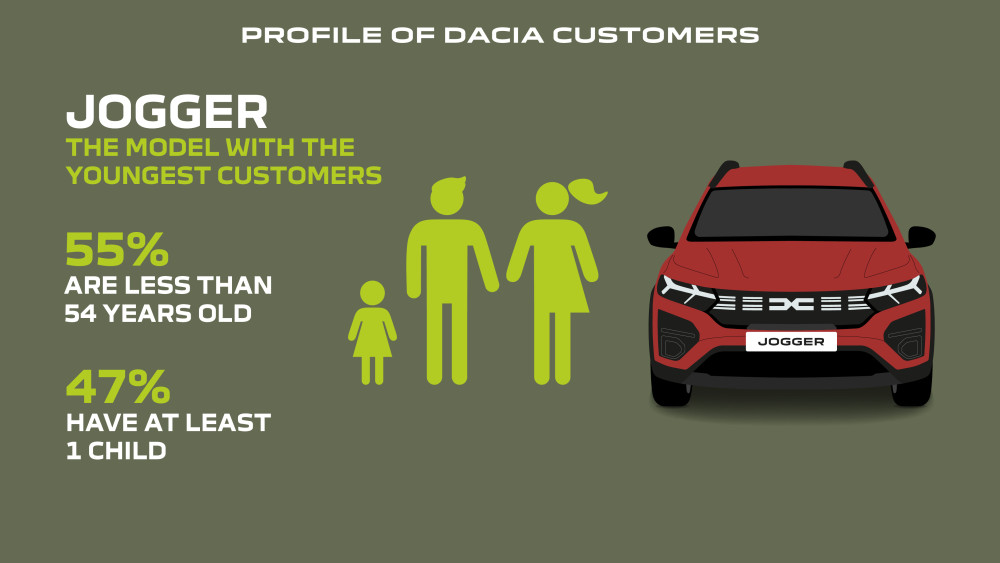
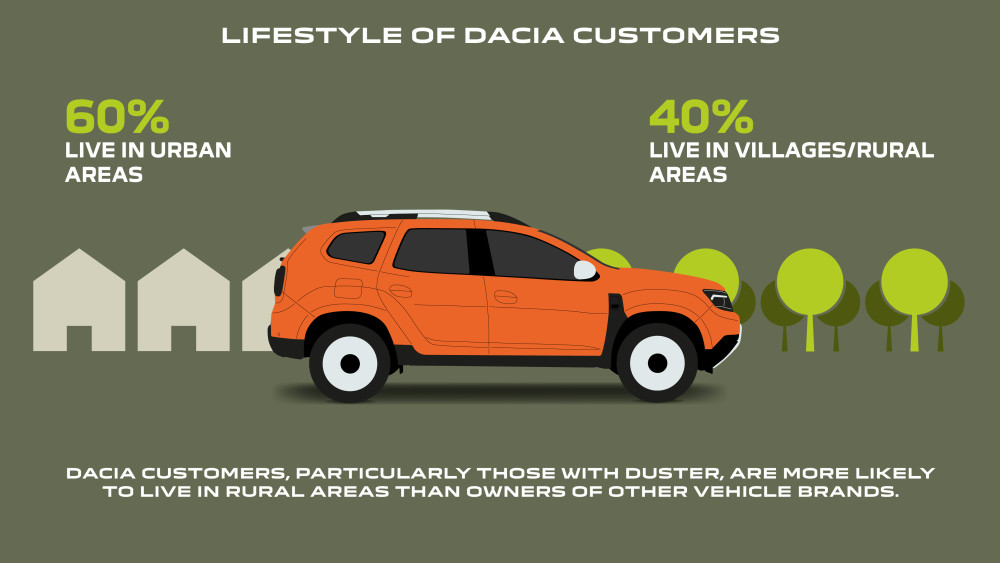
Born in 1968 then launched throughout Europe and the Mediterranean region in 2004, Dacia has always offered cars with the best value for money, while constantly redefining that which is essential. A disruptive brand, Dacia designs vehicles that are simple, versatile, reliable, and that suit the lifestyles of its customers. Dacia models have become market benchmarks: Logan, a new car at second-hand prices; Sandero, the best-selling private car in Europe every year since 2017; Duster, the most sold SUV to retail customers in Europe since 2018; Spring, European champion of affordable electric mobility; Jogger, the versatile C-segment family car. Present in 44 countries, Dacia has sold more than 8 million vehicles since 2004.
Media library (12)
Born in 1968 then launched throughout Europe and the Mediterranean region in 2004, Dacia has always offered cars with the best value for money, while constantly redefining that which is essential. A disruptive brand, Dacia designs vehicles that are simple, versatile, reliable, and that suit the lifestyles of its customers. Dacia models have become market benchmarks: Logan, a new car at second-hand prices; Sandero, the best-selling private car in Europe every year since 2017; Duster, the most sold SUV to retail customers in Europe since 2018; Spring, European champion of affordable electric mobility; Jogger, the versatile C-segment family car. Present in 44 countries, Dacia has sold more than 8 million vehicles since 2004.
Related topics
